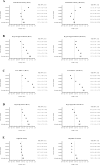Trends in the prevalence of metabolic syndrome and its components in South Korea: Findings from the Korean National Health Insurance Service Database (2009-2013)
- PMID: 29566051
- PMCID: PMC5864027
- DOI: 10.1371/journal.pone.0194490
Trends in the prevalence of metabolic syndrome and its components in South Korea: Findings from the Korean National Health Insurance Service Database (2009-2013)
Abstract
Background: The prevalence of metabolic syndrome has markedly increased worldwide. However, studies in the United States show that it has remained stable or slightly declined in recent years. Whether this applies to other countries is presently unclear.
Objectives: We examined the trends in the prevalence of metabolic syndrome and its components in Korea.
Methods: The prevalence of metabolic syndrome and its components was estimated in adults aged >30 years from the Korean National Health Insurance Service data from 2009 to 2013. The revised National Cholesterol Education Program criteria were used to define metabolic syndrome.
Results: Approximately 10 million individuals were analyzed annually. The age-adjusted prevalence of metabolic syndrome increased from 28.84% to 30.52%, and the increasing trend was more prominent in men. Prevalence of hypertriglyceridemia, low HDL-cholesterol, and impaired fasting plasma glucose significantly increased. However, the prevalence of hypertension decreased in both genders. The prevalence of abdominal obesity decreased in women over 50 years-of-age but significantly increased in young women and men (<50 years).
Conclusions: The prevalence of metabolic syndrome is still increasing in Korea. Trends in each component of metabolic syndrome are disparate according to the gender, or age groups. Notably, abdominal obesity among young adults increased significantly; thus, interventional strategies should be implemented particularly for this age group.
Conflict of interest statement
Figures



Similar articles
-
Prevalence and Trends of Metabolic Syndrome in Slovakia during the Period of 2003-2012.Cent Eur J Public Health. 2017 Dec;25(4):313-320. doi: 10.21101/cejph.a4968. Cent Eur J Public Health. 2017. PMID: 29346856
-
Trends in the prevalence of metabolic syndrome and its components in the United States 2007-2014.Int J Cardiol. 2018 May 15;259:216-219. doi: 10.1016/j.ijcard.2018.01.139. Epub 2018 Feb 19. Int J Cardiol. 2018. PMID: 29472026
-
Increasing prevalence of metabolic syndrome in Korea: the Korean National Health and Nutrition Examination Survey for 1998-2007.Diabetes Care. 2011 Jun;34(6):1323-8. doi: 10.2337/dc10-2109. Epub 2011 Apr 19. Diabetes Care. 2011. PMID: 21505206 Free PMC article.
-
Hypertension and the metabolic syndrome.Curr Cardiol Rep. 2004 Nov;6(6):427-33. doi: 10.1007/s11886-004-0050-7. Curr Cardiol Rep. 2004. PMID: 15485602 Review.
-
Gender differences in the metabolic syndrome and their role for cardiovascular disease.Clin Res Cardiol. 2006 Mar;95(3):136-47. doi: 10.1007/s00392-006-0351-5. Epub 2006 Jan 30. Clin Res Cardiol. 2006. PMID: 16598526 Review.
Cited by
-
Does REM Sleep-Dependent Obstructive Sleep Apnea Have Clinical Significance?Int J Environ Res Public Health. 2022 Oct 29;19(21):14147. doi: 10.3390/ijerph192114147. Int J Environ Res Public Health. 2022. PMID: 36361024 Free PMC article.
-
Synergistic Interaction between Hyperuricemia and Abdominal Obesity as a Risk Factor for Metabolic Syndrome Components in Korean Population.Diabetes Metab J. 2022 Sep;46(5):756-766. doi: 10.4093/dmj.2021.0166. Epub 2022 Jan 20. Diabetes Metab J. 2022. PMID: 35045592 Free PMC article.
-
Metabolic risks in living kidney donors in South Korea.Kidney Res Clin Pract. 2021 Dec;40(4):645-659. doi: 10.23876/j.krcp.20.271. Epub 2021 Oct 12. Kidney Res Clin Pract. 2021. PMID: 34781645 Free PMC article.
-
Body impedance analyzer and anthropometric indicators; predictors of metabolic syndrome.J Diabetes Metab Disord. 2021 Jul 13;20(2):1169-1178. doi: 10.1007/s40200-021-00836-w. eCollection 2021 Dec. J Diabetes Metab Disord. 2021. PMID: 34277496 Free PMC article.
-
Clustering of Elevated Blood Pressure, Elevated Blood Glucose, and Abdominal Obesity Among Adults in Dire Dawa: A Community-Based Cross-Sectional Study.Diabetes Metab Syndr Obes. 2020 Jun 16;13:2013-2024. doi: 10.2147/DMSO.S250594. eCollection 2020. Diabetes Metab Syndr Obes. 2020. PMID: 32606860 Free PMC article.
References
-
- Haffner SM, Valdez RA, Hazuda HP, Mitchell BD, Morales PA, Stern MP. Prospective analysis of the insulin-resistance syndrome (syndrome X). Diabetes. 1992; 41: 715–722 - PubMed
-
- Isomaa B, Almgren P, Tuomi T, Forsen B, Lahti K, Nissen M, et al. Cardiovascular morbidity and mortality associated with the metabolic syndrome. Diabetes Care. 2001; 24: 683–689 - PubMed
-
- Lakka HM, Laaksonen DE, Lakka TA, Niskanen LK, Kumpusalo E, Tuomilehto J, et al. The metabolic syndrome and total and cardiovascular disease mortality in middle-aged men. JAMA. 2002; 288: 2709–2716 - PubMed
-
- Borch-Johnsen K. The metabolic syndrome in a global perspective. The public health impact—secondary publication. Dan Med Bull. 2007; 54: 157–159 - PubMed
-
- Pitsavos C, Panagiotakos D, Weinem M, Stefanadis C. Diet, exercise and the metabolic syndrome. Rev Diabet Stud. 2006; 3: 118–126. doi: 10.1900/RDS.2006.3.118 - DOI - PMC - PubMed
MeSH terms
Substances
LinkOut - more resources
Full Text Sources
Other Literature Sources
Medical

